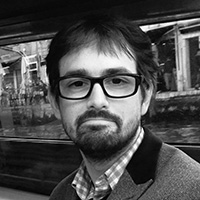
5 minute read
Remapping landscapes to redefine their regenerative capacities
Manchester School of Architecture’s Infrastructure Space Atelier puts forward a pedagogy and practice-led digital methodology for design.
Infrastructure Space is a research and teaching atelier at the Manchester School of Architecture, focusing on mapping the functionality, productivity, experience and capacity of landscapes and their infrastructures. By analysing the complex interactions within territories, the studio develops speculations on how to meet the needs of present and future societies.
Following the work of architects Stan Allen and Ignasi de Solà-Morales, the atelier explores systems, flows and infrastructures that shape landscapes and places. Initially centred on the disciplines of architecture and urbanism, the atelier has expanded to embrace a transdisciplinary approach. Today, staff and students from the Master of Landscape Architecture and Architecture programmes work collaboratively and engage with practitioners and policymakers from a range of cognate disciplines.
Atelier ethos and theoretical foundations
The atelier theorises that place can be analysed as a ‘stack’ of processes, which are interconnected. The theory builds on Benjamin Bratton’s stack, to question how multi-scalar computation and advanced understandings of multi-disciplinary datasets influence geopolitical realities. Formerly, we defined the processes of this ‘stack’ as spatial, social, societal, digital/ technological, economic and political. The inclusion of landscape architecture has now embedded a new ‘ecological’ layer.
This draws on Ian McHarg’s ‘layer cake’ methodology, which involved overlaying maps to spatialise an array of environmental and ecological datasets, seeking to reconcile human and ecological needs in decision-making.
The atelier’s approach of stacking and synthesising data from multiple disciplines, combined with the spatialisation of typically non-spatial data such as policy documents, provides novel insights into the territory of study which could not be achieved without a transdisciplinary approach.
Data mapping
The multi-methods approach was applied to Cumbria during the 2023 academic year and began with a data mapping exercise where 12 research groups explored the territory through multidisciplinary lenses. The selected datasets intentionally overlapped to encourage groups to examine similar or conflicting data, fostering critical inquiry. The students’ analysis was interpreted and articulated to a diverse group of stakeholders from public sector, industry and local communities, who served as consultants to the students’ work. Both quantitative and qualitative data were spatialised to produce a complex understanding of Cumbria

Data mapping is predominantly a digital exercise. Students take a critical approach to the data, its sources and the software used to generate meaningful analytical outcomes and visual representations. We encourage students to be agnostic about the software they use and indeed question if digital tools are advantageous. The translation of data from non-spatial to spatial representation allows for rapid questioning and critique, but in some cases the use of digital tools can be time-consuming and may introduce bias. As such, hybridised techniques utilising open-source text, image and video analytics software result in a method where data can be increasingly interrogated and understood spatially.
Articulate and exhibit to stakeholders
The engagement with stakeholders serves as a form of consultancy, whereby stakeholders may challenge the interpretation and assumptions of data or point students towards alternative sources. Engagement activities recur at pivotal points during the design process, with students assessing gathered information and critically evaluating their positions relative to stakeholders, to develop responsive proposals and test design hypotheses. Stakeholder engagement methods include exhibitions, roundtable interviews and formal critiques.
Exhibitions aim to challenge assumptions and foster public debate. Topics in 2023 included perceptions of the nuclear industry in Cumbria, the Lake District National Park policy and climate change. Interactive installations raised questions about the use of digital or analogue technologies to engage visitors. Visitors responded to questions about climate change within a physical space and video analytics were used to record trends, with digital and analogue approaches found to engage users more than singular modes of representation, again reinforcing a hybridised approach.
Exhibitions and stakeholder engagement, held alongside data mapping outcomes, resulted in critical responses to research questions and territories which are used to support the development of design principles and design speculations. This process empowers both the voices of individuals and that of wider group consensus, requiring students to consolidate contrasting viewpoints.
Design principles and speculations
The multi-methods illustration highlights points of tension between traditional design and emerging computational, technological and artificial intelligence (AI) tools. Challenges occur where there is a need to articulate ideas, as students transition from the speculative to the grounded. Traditional understanding of the critical context and anticipated outcomes of a project is essential to effectively apply any tool and while digital tools may increase the efficiency and speed of iterative processes, they have limitations. Midjourney and DALL-E have been used to support iterative design speculation powered by language-based prompts, again reinforcing the importance of design principles as critical parameters for AI-generated outputs. The potential infinite outcomes of computational algorithms require this structure.
Conclusions
Further testing of the methodology is needed to refine and validate the approach, as we aim to strengthen existing stakeholder relationships and forge new ones. The ambition is to expand our network and broaden our transdisciplinary practices to produce increasingly holistic design speculations. We will include a greater number of project sites with associated stakeholders and integrate new experts in computation and AI. This will support new forms of speculative design, governed by critically informed design principles. We will further challenge disciplinary boundaries by increasing opportunities for shared knowledge exchange and the development of projects co-created by landscape architecture and architecture students supporting the design of transdisciplinary regenerative landscapes.



Dr Richard James Morton and Dawn Parke are senior lecturers at Manchester School of Architecture.










